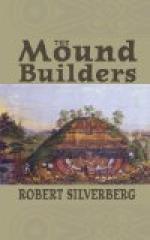Burial Mounds.—As in modern days, a place of sepulture is usually selected some distance from the city or town, so the burial mounds may be expected without the enclosures. In our own time we find some cemeteries densely populated with graves, and others have but few. So it was in the days of the Mound-builders; for we find in some places groups of burial mounds, and in other places only a few may be found scattered over the plain.
Burial mounds are of various sizes, I presume, according to the dignity of the individual entombed. Sometimes one large mound is found to possess a skeleton, and some interesting relics, which indicate the position of the departed, while a group of smaller mounds is situated around it. The large one perhaps contained the skeleton of a leader, surrounded by a few of his intimate followers. Or perhaps it was that of a patriarch, surrounded by his numerous progeny, much as, in our own day, burial plots are set apart for families.
Grave Creek burial mound, which stands at the junction of Grave Creek, Virginia, with the Ohio, is one of the largest and most important burial mounds in America. It is 70 feet in height and at its base it is 1,000 feet in circumference. When this mound was opened, two vaults were found, one at the base contained two skeletons, one of them a female. The logs of which this vault was composed were all decayed, and the earth and stones lay upon the skeletons. In the upper vault there was a single skeleton very much decayed. Within these vaults and beside the illustrous dead, were found more than 3,000 shell-beads, ornaments of mica, copper bracelets, and other stone carvings. Around the lower vault were found ten much decayed skeletons, all in a sitting posture.
The skeletons in the vaults, doubtless, were the remains of royalty, or some distinguished chiefs, whose memory these devoted people desired to perpetuate, while the ten skeletons, which surrounded the vault, were perhaps some of their loyal subjects who were sacrificed according to the custom of some of the heathen nations both ancient and modern. Foster, desiring to draw a comparison or rather identify this mode of burial with those of the Greeks and other nations, directs our attention to Herodotus, Book IV, Chaps. 71 and 190. And for identifying the ceremonial with the funeral of Achilles, our attention is called to the Odyssey, Book XXIV, with the burial of Hector in the Iliad, Book XXIV.
Dr. Wilson identifies the burial of the living with the dead by giving an account of the burial of Black Bird, the great chief of the Omahas more than 60 years ago. He caught the smallpox at Washington, and dying on his way home, he gave instructions to his braves around him how he was to be buried. “His body was clothed with the gayest Indian robes, decorated with scalps and war eagle plumes, and he was carried to one of the loftiest bluffs on the Missouri. He was placed upon his favorite war horse, a beautiful




